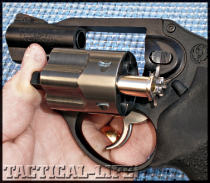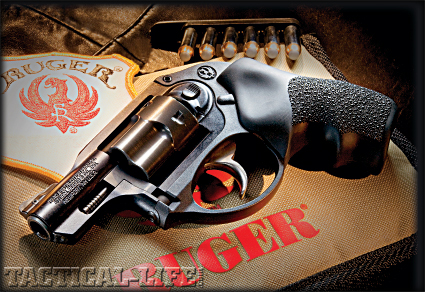When I entered law enforcement in the mid-1970s, the revolver was king. Concerns over weapon effectiveness were normally directed towards the caliber of the gun as few doubted that the revolver could deliver. During this time, the snub-nosed .38 was the off-duty and plainclothes carry gun with the Smith & Wesson Chief’s Special and Colt Detective Special (as well as their variations) being the only real choices.
 When I graduated from the Sheriff’s Academy, I purchased a Security Industries J-frame .357 Mag revolver, and even though the gun worked very well, it was accurate and chambered the more powerful .357 cartridge. My agency’s range officer told me the gun was junk and that I should get a S&W or Colt. It was stupid. The gun was ahead of its time as J-frame .357s are now plentiful. If a polymer revolver had appeared during this period of time, I’m guessing that traditionalists would sluff it off much like the compact .357 that I once (and still wish I did) owned.
When I graduated from the Sheriff’s Academy, I purchased a Security Industries J-frame .357 Mag revolver, and even though the gun worked very well, it was accurate and chambered the more powerful .357 cartridge. My agency’s range officer told me the gun was junk and that I should get a S&W or Colt. It was stupid. The gun was ahead of its time as J-frame .357s are now plentiful. If a polymer revolver had appeared during this period of time, I’m guessing that traditionalists would sluff it off much like the compact .357 that I once (and still wish I did) owned.
Last year, Ruger created excitement with the introduction of their palm-sized, 9-ounce .380 Lightweight Compact Pistol (LCP). Ruger did not disappoint this year with the introduction of their next-generation revolver, made of steel and polymer, the LCR (Lightweight Compact Revolver).
Advertisement — Continue Reading Below
The LCR is not just another short-barreled revolver with compact dimensions. Ruger has put a lot of time and money into the design of the LCR, particularly the geometry of the internal components and how they inner-connect. This is a truly unique design in materials, form and function. It is the revolver of the 21st century and it just might change the way we all think of the old wheelgun.
Gun Details
The LCR differs from other revolvers due to its unique design. The 13.5-ounce, small-frame, 5-shot LCR has three main components: a polymer fire control housing, an aircraft aluminum monolithic frame and an extensively fluted stainless steel cylinder. The long-fiber, glass-filled polymer fire control housing provides a reduction in felt recoil. The grip peg allows for a variety of grips to be installed with the LCR’s standard Hogue “Tamer” grip made with an insert that actually reduces recoil even further.
A joint effort with Hogue Grips, the LCR’s factory grip was designed using US military anthropomorphic data on hand configuration, so the LCR can comfortably accommodate a wide range of hand sizes. An available Crimson Trace Lasergrip offers the advantages of a laser sighting system.
Advertisement — Continue Reading Below
The LCR’s monolithic frame is an aerospace grade, 7000 series aluminum forging treated with a black hard coat that is applied after machining. Successfully tested with over 30 different aggressive chemicals, this hard coat exceeds mil-spec salt spray tests and offers performance much greater than hard coat anodizing. The monolithic frame provides solid support for the cylinder and the barrel, which is just under 2 inches in length with a 1-in-16-inch twist. The barrel sleeve is made of 17-4 pH aerospace grade stainless steel, which was chosen for its strength and stability during machining and heat treatment.
The aggressively fluted 400 series stainless steel cylinder is lightweight and compact, measuring only 1.25 inches in diameter in the chamber area. Treated to an advanced form of Ruger’s Target Grey finish, this stainless steel cylinder is strong, durable and designed to handle hot .38 Special +P loads. The Ruger LCR’s cylinder front locking system uses titanium components, which optimizes spring tension while enhancing lockup geometry to ensure that the LCR’s cylinder stays solidly in place during rapid fire.
The LCR’s lightweight, chemical-resistant polymer fire control housing contains the entire trigger mechanism. Because these components are located within this single housing, their relationship can be held to tighter tolerances than if divided between the more conventional grip and cylinder frames. The result is these components are assembled with no hand fitting, resulting in a consistent and affordable product. The LCR’s double-action-only (DAO) trigger pull (the hammer is completely encased in the frame and though it looks like an S&W Bodyguard, no manual cocking can be done) is uniquely engineered to minimize friction between the firing components.
Advertisement — Continue Reading Below
This friction-reducing trigger system results in a very smooth trigger pull that does not stack due to spring tension at the end of the stroke. No exaggeration—this is the best snubby trigger action I have ever felt from a factory revolver and I do not make that claim lightly. The LCR’s trigger weight builds gradually and peaks later in the stroke, resulting in a trigger pull that feels much lighter than it actually is.
The sights are replaceable ramp front and a fixed U-notch rear that is precisely cut and offers a clear sight window. The only modification that I made to the LCR was to add some orange paint to the front sight so that I would have a “reference” for quick shooting. Trying for a conventional sight picture with the small gun will be difficult, if not impossible, in a fight. The orange front ramp is my version of a laser dot that will interrupt the eye/target line.
.38 Snubby Effectiveness
Many authorities considered the .38 snubby to be marginally effective, but I have not found this to be the case over the last 30 years. The .38 snubby has proven to be effective in gunfights in extreme close-quarter conflicts. It might be the ultimate weapon as its short barrel and small frame make is harder to grab by an opponent and when used as a contact weapon, the gun is unlikely to be fouled by blood and other materials that could spray back from a wound. And unlike an autopistol, a contact shot would not take the gun out of the battery.
Advertisement — Continue Reading Below
The snub .38 is similar to the 9mm pistol in that it is a good choice for personal defense, but only when loaded with the best ammo. As history has shown, there is a big difference in the performance of the 9mm from load to load with certain ammo styles being standouts. The same is the case with the .38 snub, but when loaded with one of these proven loads, it will do the job if the shooter can do theirs.
The 158-grain all-lead hollow point (LHP), sometimes known as the semi-wadcutter hollow point, is probably the most proven load in history. Having been in existence for almost 40 years, the LHP has proven to be a solid performer in 2-, 4- and 6-inch .38 revolvers. Since it has no copper jacket to “peel,” the LHP will deform as lesser velocities than other rounds while its weight offers good penetration.
Several years ago, Speer offered their 135-grain Gold Dot +P hollow point at the request of the New York City’s PD as they wanted a load for their officers that carried .38 snubs that was as effective as their 124-grain Gold Dot +P 9mm duty load. In just a few years, this load has developed an impressive track record on the street and is probably the best load to carry in the Ruger LCR. While actual shooting results are minimal at this time, the 110-grain CorBon DPX +P hollow point also showed great potential. The all-copper Barnes-X bullet offers both expansion and penetration from a bullet that is traveling very fast from a 2-inch barrel. While I only know of two snub .38 shootings with this load, both were quite impressive.
Advertisement — Continue Reading Below
Since I am quite familiar with these loads in actual shootings, I decided to use them at the range as I ran the Ruger LCR through its paces. While the new snubby sure looks good, the only way to really know if the gun is a winner is to shoot it for both accuracy as well as some fast action training drills. For this, I was going to enlist the help of the new MotoShot moving target system.
Range Time
The MotoShot is described as an “affordable reality-based robot training system.” Unlike similar units that are armored and cost four times as much, the MotoShot can be carried by one person and transported in the trunk of a car. It is a digital unit with a 2.4 GHz digital spread spectrum with variable speeds both forward and back. The control unit is much like a toy car with a trigger that controls speed and a side-mounted wheel that steers it, but it much more powerful.
The MotoShot can be used as far as 1000 meters (line of sight) from the target making it useful for long range training. In its basic form, the MotoShot uses a humanoid torso target attached to an electronic sensor. When the torso is hit by gunfire, it stops instantly. However, I would recommend the upgraded unit with the reactive target feature, which allows the torso to fall over when hit. This is accomplished via an ingenious magnet system that holds the target upright, but when hit, the magnet releases the target, allowing it to fall.
Advertisement — Continue Reading Below
What this results in is a humanoid target that can move much like a human being, offering a more realistic training experience. Since the LCR is designed for personal defense, this target would seem to be a natural for testing the small combat revolver.
I shot the LCR at 50 feet for accuracy using both a bench rest and free standing. I did this to see how accurate it is to see what one could expect when using it in the street.
Ruger really nailed this gun! The trigger pull on the LCR is very smooth and light for a pocket revolver. Many similar guns have awful trigger pulls that make it difficult to use them quickly and accurately. If the production LCRs are like the one that I tested, there may be a glut of snub revolvers on the shelves while folks search for LCRs. That gun had almost a perfect trigger pull for a compact revolver—a smooth, easy DA, but not so much that a negligent discharge is inevitable.
Advertisement — Continue Reading Below
According to my trigger weights, the pull on my test gun was 8.5 pounds, which is terrific for a DA revolver. No perceptible staging was evident, and as compared to Ruger’s SP101, the LCR feels like it has been to a gunsmith. The Hogue rubber grips really help when using the loads described above as all are on the “stout” side when it comes to recoil impulse.
Final Notes
My son-in-law and I put the LCR through its paces in a number of drills and the LCR proved to be quite the performer within its operations parameters at 10 yards or so. Using the MotoShot target added realism to the drills, which should be added to any real world-based training program. The LCR is a close-quarter defense gun intended for concealed carry, not a target pistol. When used as intended, the Ruger LCR holds up its end, so it’s up to the shooter to do their part. This gun is going to be as popular as the LCP .380, so if you happen to find one, buy it. You will be glad you did.
Advertisement — Continue Reading Below
























